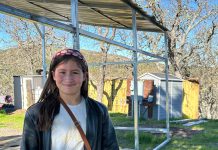As arid as our landscape usually is, we’re located in the middle
of a colossal river.
It’s a river of birds traversing the Pacific Flyway each year.
The flyway is perhaps better described as a funnel or hourglass
than a river. Birds dispersed over a broad area through winter are
back on the move, heading to their summer range. Next fall, the
drama will be repeated.
As arid as our landscape usually is, we’re located in the middle of a colossal river.
It’s a river of birds traversing the Pacific Flyway each year. The flyway is perhaps better described as a funnel or hourglass than a river. Birds dispersed over a broad area through winter are back on the move, heading to their summer range. Next fall, the drama will be repeated.
I describe this natural cycle as a drama because it is very much so. Creatures, many of them weighing only ounces, make a globe-spanning commute each year. Most migrants travel at night, in some locations, their voices can be heard as they race through the blackened sky.
Birds don’t migrate the way most of us conduct road trips, with daily legs of about equal length. They travel epic distances, alighting in a suitable spot – if they’re lucky – as they flirt with starvation. If they’ve found a suitable spot, safe from predators, sheltered from weather and offering plenty of food, they’ll remain for a while, adding fat reserves in preparation for the next epic leg of their trip.
The journey is most hazardous for birds doing it for the first time. It’s one reason why each year birds that are usually found in the eastern U.S. or Asia crop up on the West Coast. Inexperienced birds sometimes take a wrong turn or two. If a bird survives the journey the first time, it will often stop to refuel at the same sites year after year, based on data recorded at bird banding stations.
Like many phenomena, migration carries its own language. Biologists and birders talk of “fallouts,” a collision of circumstances that fosters conditions likely to concentrate astounding numbers of arriving birds.
Sometimes, heavy fog in coastal areas prompts birds to find cover in the first patch along the coast offering shelter and fresh water. The mouths of the Big Sur and Carmel Rivers sometimes experience fallouts. The most famous fallouts, however, occur at a few places on the Texas coast after a hard northern wind. Small migrants from the tropics arrive after crossing the Caribbean, exhausted and starving. In a serious fallout, the shrubs and trees along the coast can be filled with countless birds of dozens of species.
In the last few days, Cliff Swallows have started to return. Western Kingbirds are back, their sulfur-yellow bellies illuminating them from their perches on rural utility lines. Black-headed Grosbeaks, a menu of warblers, Bullock’s Orioles, all are making their 2006 North American debut over the last week or two.
Considering its risks, and the extraordinary effort, the first question about migration might be “why go to the trouble?”
The reasons vary, species by species, but they all boil down to three things: food, habitat and breeding opportunities.
The fall migration is easier to explain and to understand. Migrants are fleeing the cold and dark of the northern winter.
Many shorebirds breed in the Arctic. The birds’ high metabolisms require that to sustain themselves and their young, they must locate themselves where long days and abundant food allow for profitable foraging. Welcome to the Yukon.
In addition to anticipating the return of a host of birds wearing tropical colors each year, migration carries with it other lessons.
I can think of no better illustration of the importance of that bumper sticker philosophy that exhorts us to “Act local, think global.”
Disappearing migrants might be an early signal that logging forests in Central America, or in our own Northwest, is having far reaching effects. The Texas fallouts illustrate graphically the importance of maintaining islands of habitat. While birders may “ooh” and “aah” at the spectacle, each bird that makes it to shore likely signals several like it that perished at sea. When they arrive – if they arrive – they cannot look too long for a suitable place to refuel.
To get a look at migration unfolding in our own backyards, it pays to think for a moment like an arriving bird. Wherever shelter and water come together is a good place to go looking. In Morgan Hill, the Coyote Creek pathway is a likely spot. Near Gilroy, Llagas Creek near Bloomfield Road is exploding with new life. Hollister’s own curious spot is Vista Park Hill, an island of trees overlooking downtown Hollister and the agricultural plain that surrounds it. This small urban park – visible from my office – is a great opportunity to think about migration and our place on a much larger landscape, one spanning the planet.









